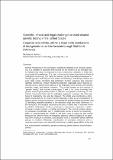| dc.description.abstract | Human monitoring in the workplace, sometimes referred to as medical screening,
is a collation of practices that focuses on the workers as an indicator that:
1) disease may result on exposure to a toxic substance, radiation, or other traumas
(medical surveillance); 2) a toxic substance has been absorbed into the body
(biological monitoring); 3) a particular worker may be especially predisposed to
disease (genetic screening or other probes of sensitivity); and 4) a pre-clinical disease
state exists, indicating that potentially harmful exposure has occurred
(genetic monitoring). These monitoring practices, especially when required or
carried out by a government agency or the employer, raise serious and complex
scientific, legal, and ethical concerns. This article focuses on the practice of
“genetic testing” that involves mainly types 3 and 4, i.e., those involving both
genetic screening for predisposition to disease, and genetic monitoring for indications
of potential harm due to workplace exposure. However, the other two
types of monitoring may also be relevant. The article also constructs a philosophic
framework for: 1) examining the adequacy of law as an embodiment of
ethical values, and sound science, concerning the genetic testing of workers; and
2) identifying possible solutions to the attendant legal and moral dilemmas. In
the workplace, the analysis necessarily focuses on three sets of activities involving
distinct participants: workers, employers, corporations, physicians – either
in-house or under contract – and the government. The sets of activities deserving
separate consideration are: 1) requiring the worker to submit to monitoring
tests; 2) disseminating the results of the tests; and 3) using the test results.
Because the different kinds of monitoring address different stages of the pathway
from exposure to disease, and because what is monitored affects different
groups of workers differently, specification of exemplar problems and a
case-by-case analysis are essential, lest we face useless generalities at the end. | en_US |
